Abstract
Pelvic hemorrhage has been implicated as the cause of death in 50% of patients who die following pelvic fractures. To establish correlates of morbidity and mortality from pelvic fractures due to blunt trauma, we reviewed 236 patients treated during 4 years. The average age of the 144 men and 92 women was 31.5 years, the average Injury Severity Score was 21.3, the average blood requirement was 5 units, and the average hospital stay was 16.8 days. One hundred fifty-two patients (64.4%) were injured in motor vehicle accidents, 33 (14%) had motor vehicle-pedestrian accidents, 16 (6.8%) had crush injuries, 12 (5.1%) each had either motorcycle accidents or falls, and 11 (4.6%) had miscellaneous accidents. Eighteen patients (7.6%) died, with seven (38.9%) deaths due to hemorrhage. Only one death was caused by pelvic hemorrhage. Other deaths were due to hemorrhage from other sites (6), head injury (5), sepsis or multiple-organ failure (4), pulmonary injury (1), and pulmonary embolus (1). None of the septic deaths was related to a pelvic hematoma. Multivariate multiple regression analysis showed that the severity of injury was correlated with indices of severity of pelvic fractures such as fracture site (p less than 0.0001), fracture displacement (p less than 0.005), pelvic stability (p less than 0.0001), and vector of injury (p less than 0.01). However death could not be predicted on the basis of these indices of severity (p greater than 0.28). Of the nine patients who underwent pelvic arteriography, three required embolization of actively bleeding pelvic vessels, but seven had intra-abdominal hemorrhage that required laparotomy, and eight developed a coagulopathy. Massive bleeding from pelvic fractures was uncommon, and the major threat of hemorrhage was from nonpelvic sites. Furthermore, although injury severity was correlated with the severity of the pelvic fracture, hospital outcome was determined by associated injuries and not by the pelvic fracture.
Full text
PDF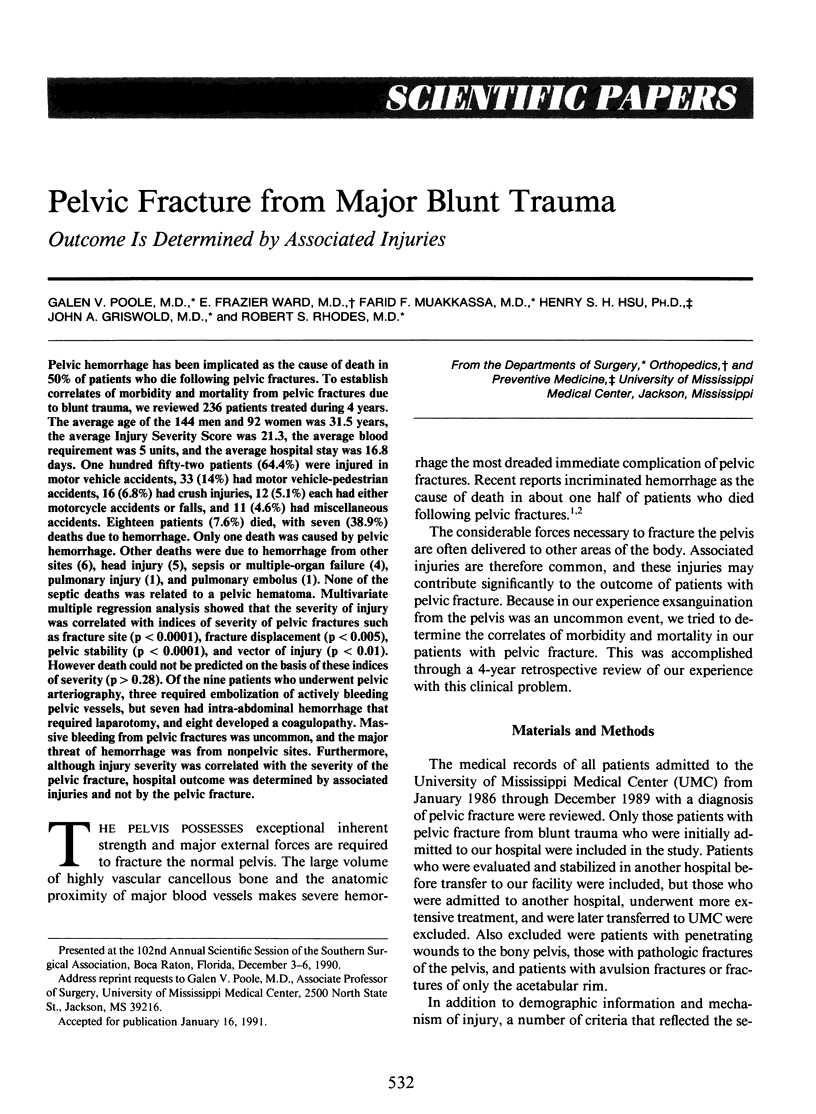
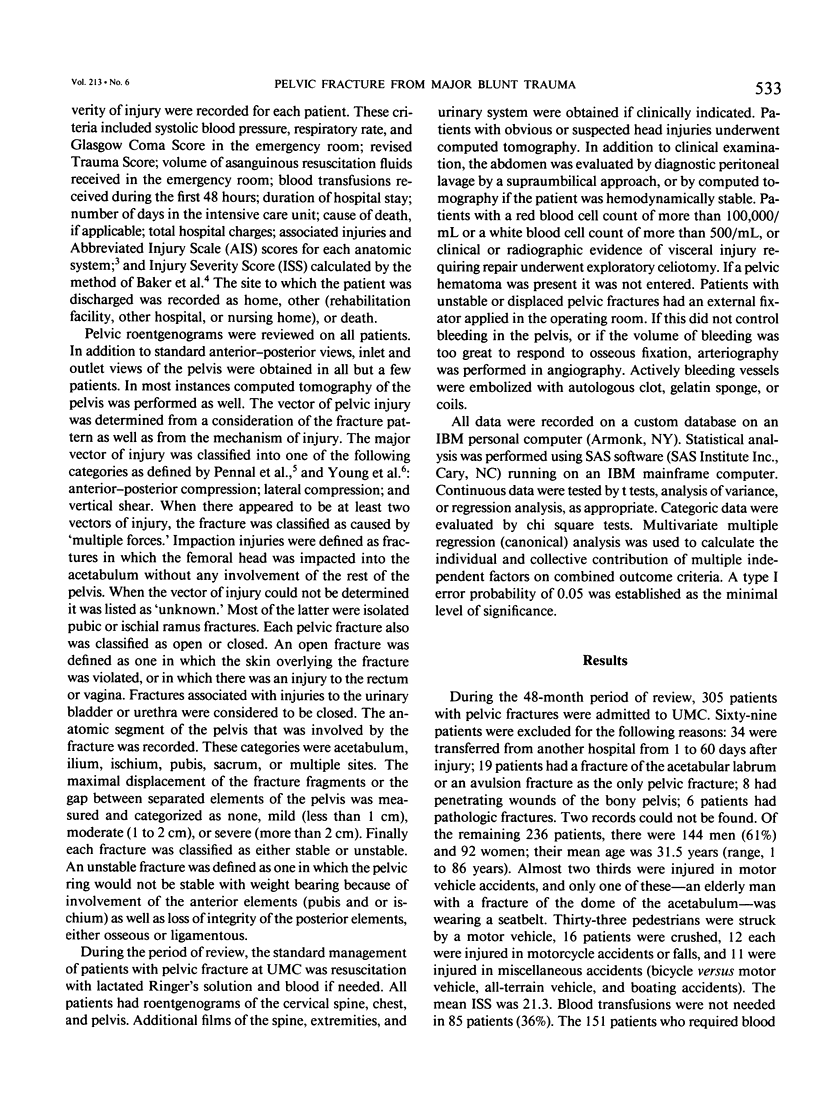
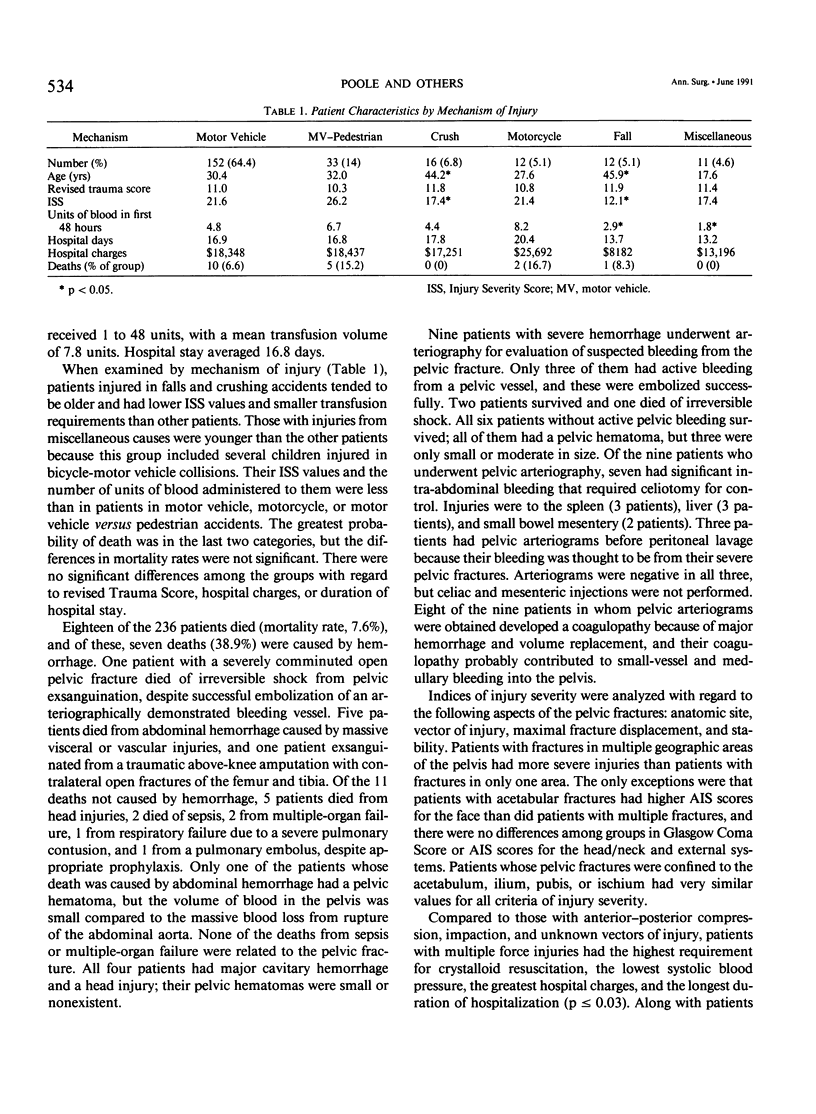
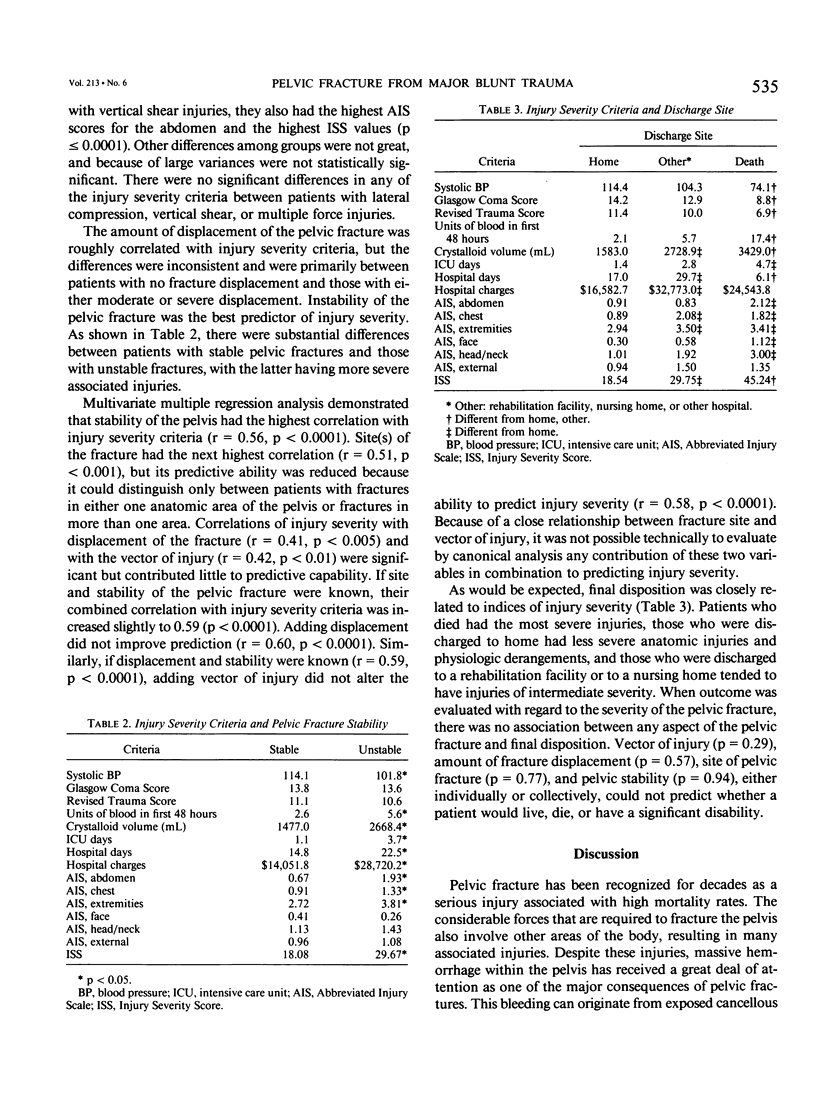
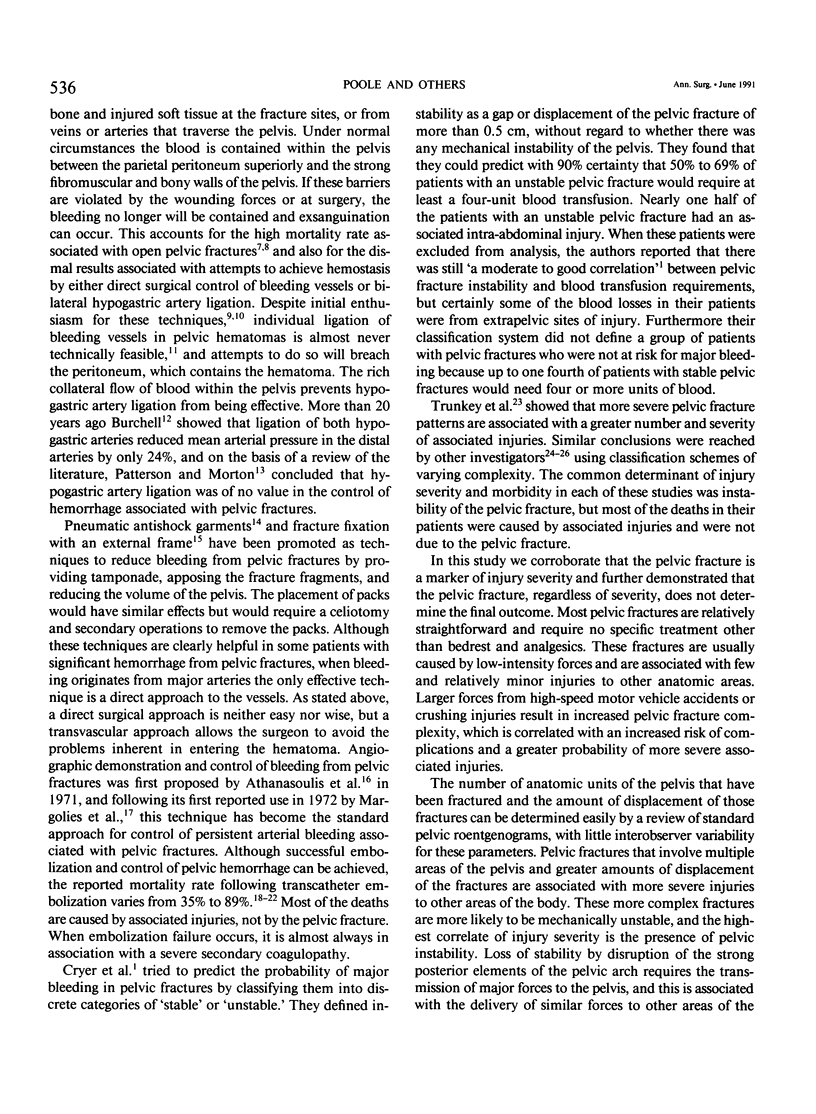
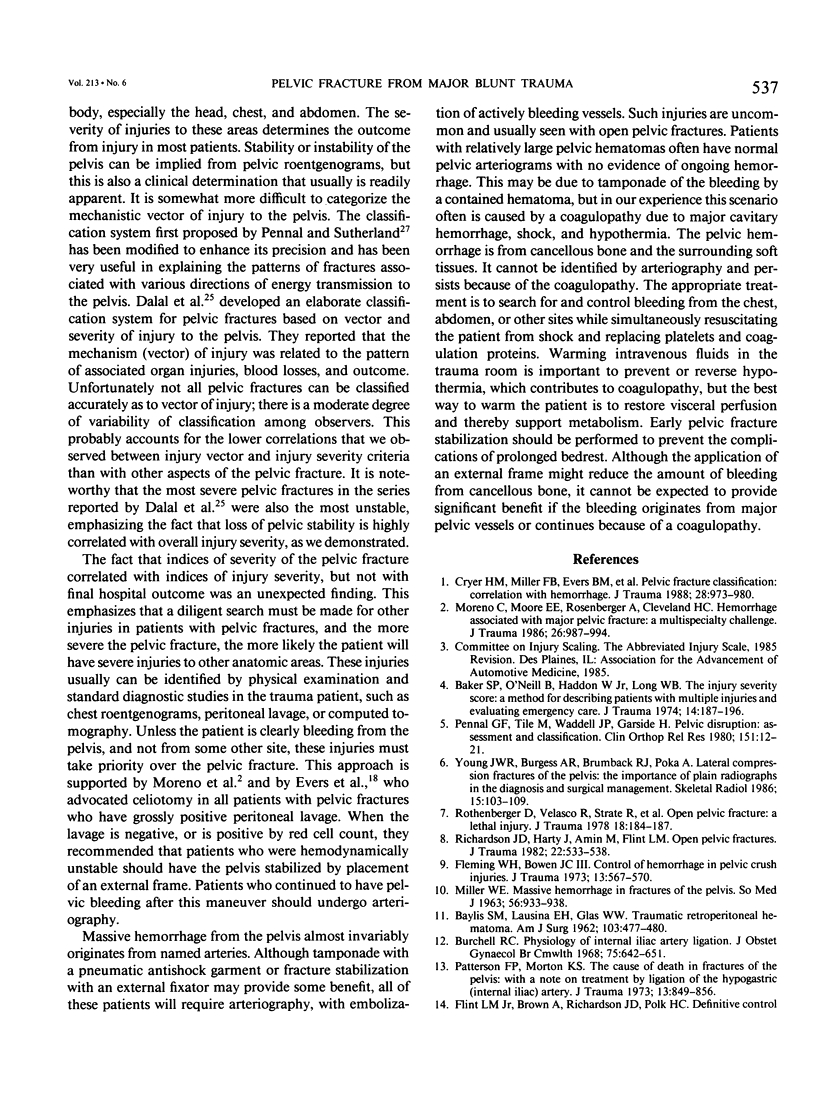
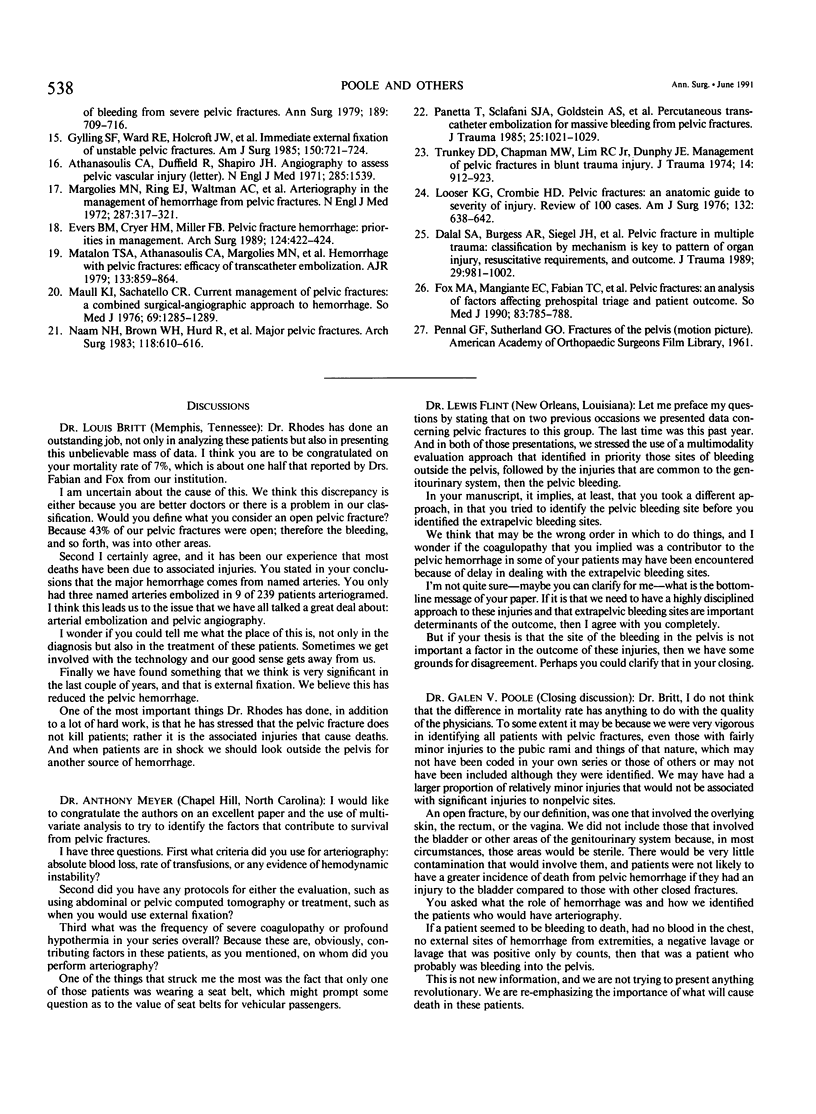
Selected References
These references are in PubMed. This may not be the complete list of references from this article.
- BAYLIS S. M., LANSING E. H., GLAS W. W. Traumatic retroperitoneal hematoma. Am J Surg. 1962 Apr;103:477–480. doi: 10.1016/0002-9610(62)90156-3. [DOI] [PubMed] [Google Scholar]
- Baker S. P., O'Neill B., Haddon W., Jr, Long W. B. The injury severity score: a method for describing patients with multiple injuries and evaluating emergency care. J Trauma. 1974 Mar;14(3):187–196. [PubMed] [Google Scholar]
- Burchell R. C. Physiology of internal iliac artery ligation. J Obstet Gynaecol Br Commonw. 1968 Jun;75(6):642–651. doi: 10.1111/j.1471-0528.1968.tb00175.x. [DOI] [PubMed] [Google Scholar]
- Cryer H. M., Miller F. B., Evers B. M., Rouben L. R., Seligson D. L. Pelvic fracture classification: correlation with hemorrhage. J Trauma. 1988 Jul;28(7):973–980. [PubMed] [Google Scholar]
- Dalal S. A., Burgess A. R., Siegel J. H., Young J. W., Brumback R. J., Poka A., Dunham C. M., Gens D., Bathon H. Pelvic fracture in multiple trauma: classification by mechanism is key to pattern of organ injury, resuscitative requirements, and outcome. J Trauma. 1989 Jul;29(7):981–1002. [PubMed] [Google Scholar]
- Evers B. M., Cryer H. M., Miller F. B. Pelvic fracture hemorrhage. Priorities in management. Arch Surg. 1989 Apr;124(4):422–424. doi: 10.1001/archsurg.1989.01410040032006. [DOI] [PubMed] [Google Scholar]
- Fleming W. H., Bowen J. C., 3rd Control of hemorrhage in pelvic crush injuries. J Trauma. 1973 Jun;13(6):567–570. doi: 10.1097/00005373-197306000-00013. [DOI] [PubMed] [Google Scholar]
- Flint L. M., Jr, Brown A., Richardson J. D., Polk H. C. Definitive control of bleeding from severe pelvic fractures. Ann Surg. 1979 Jun;189(6):709–716. doi: 10.1097/00000658-197906000-00006. [DOI] [PMC free article] [PubMed] [Google Scholar]
- Fox M. A., Mangiante E. C., Fabian T. C., Voeller G. R., Kudsk K. A. Pelvic fractures: an analysis of factors affecting prehospital triage and patient outcome. South Med J. 1990 Jul;83(7):785–788. doi: 10.1097/00007611-199007000-00017. [DOI] [PubMed] [Google Scholar]
- Gylling S. F., Ward R. E., Holcroft J. W., Bray T. J., Chapman M. W. Immediate external fixation of unstable pelvic fractures. Am J Surg. 1985 Dec;150(6):721–724. doi: 10.1016/0002-9610(85)90416-7. [DOI] [PubMed] [Google Scholar]
- Looser K. G., Crombie H. D., Jr Pelvic fractures: an anatomic guide to severity of injury. Review of 100 cases. Am J Surg. 1976 Nov;132(5):638–642. doi: 10.1016/0002-9610(76)90361-5. [DOI] [PubMed] [Google Scholar]
- Margolies M. N., Ring E. J., Waltman A. C., Kerr W. S., Jr, Baum S. Arteriography in the management of hemorrhage from pelvic fractures. N Engl J Med. 1972 Aug 17;287(7):317–321. doi: 10.1056/NEJM197208172870701. [DOI] [PubMed] [Google Scholar]
- Matalon T. S., Athanasoulis C. A., Margolies M. N., Waltman A. C., Novelline R. A., Greenfield A. J., Miller S. E. Hemorrhage with pelvic fractures: efficacy of transcatheter embolization. AJR Am J Roentgenol. 1979 Nov;133(5):859–864. doi: 10.2214/ajr.133.5.859. [DOI] [PubMed] [Google Scholar]
- Maull K. I., Sachatello C. R. Current management of pelvic fractures: a combined surgical-angiographic approach to hemorrhage. South Med J. 1976 Oct;69(10):1285–1289. doi: 10.1097/00007611-197610000-00010. [DOI] [PubMed] [Google Scholar]
- Moreno C., Moore E. E., Rosenberger A., Cleveland H. C. Hemorrhage associated with major pelvic fracture: a multispecialty challenge. J Trauma. 1986 Nov;26(11):987–994. doi: 10.1097/00005373-198611000-00005. [DOI] [PubMed] [Google Scholar]
- Naam N. H., Brown W. H., Hurd R., Burdge R. E., Kaminski D. L. Major pelvic fractures. Arch Surg. 1983 May;118(5):610–616. doi: 10.1001/archsurg.1983.01390050076015. [DOI] [PubMed] [Google Scholar]
- Panetta T., Sclafani S. J., Goldstein A. S., Phillips T. F., Shaftan G. W. Percutaneous transcatheter embolization for massive bleeding from pelvic fractures. J Trauma. 1985 Nov;25(11):1021–1029. [PubMed] [Google Scholar]
- Patterson F. P., Morton K. S. The cause of death in fractures of the pelvis: with a note on treatment by ligation of the hypogastric (internal iliac) artery. J Trauma. 1973 Oct;13(10):849–856. [PubMed] [Google Scholar]
- Pennal G. F., Tile M., Waddell J. P., Garside H. Pelvic disruption: assessment and classification. Clin Orthop Relat Res. 1980 Sep;(151):12–21. [PubMed] [Google Scholar]
- Richardson J. D., Harty J., Amin M., Flint L. M. Open pelvic fractures. J Trauma. 1982 Jul;22(7):533–538. doi: 10.1097/00005373-198207000-00002. [DOI] [PubMed] [Google Scholar]
- Rothenberger D., Velasco R., Strate R., Fischer R. P., Perry J. F., Jr Open pelvic fracture: a lethal injury. J Trauma. 1978 Mar;18(3):184–187. [PubMed] [Google Scholar]
- Trunkey D. D., Chapman M. W., Lim R. C., Jr, Dunphy J. E. Management of pelvic fractures in blunt trauma injury. J Trauma. 1974 Nov;14(11):912–923. doi: 10.1097/00005373-197411000-00002. [DOI] [PubMed] [Google Scholar]
- Wittenberg J., Athanasoulis C. A., Shapiro J. H., Williams L. F., Jr Mesenteric angiography. N Engl J Med. 1971 Dec 30;285(27):1539–1540. doi: 10.1056/NEJM197112302852720. [DOI] [PubMed] [Google Scholar]
- Young J. W., Burgess A. R., Brumback R. J., Poka A. Lateral compression fractures of the pelvis: the importance of plain radiographs in the diagnosis and surgical management. Skeletal Radiol. 1986;15(2):103–109. doi: 10.1007/BF00350202. [DOI] [PubMed] [Google Scholar]


